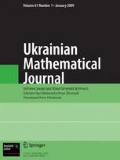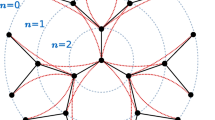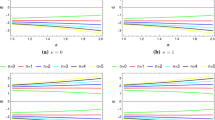The existence of an unbounded order parameter (magnetization) is established for a broad class of lattice Gibbs (equilibrium) systems of linear oscillators interacting via a strong pair nearest-neighbor polynomial potential and other many-body potentials. The considered systems are characterized by a general polynomial short-range interaction potential energy that generates Gibbs averages satisfying two generalized GKS inequalities.
Similar content being viewed by others
References
W. Skrypnik, “LRO in lattice systems of linear oscillators with strong bilinear pair nearest-neighbour interaction,” J. Phys. A, 32, 7039–7048 (1999).
W. Skrypnik, “LRO in lattice systems of linear classical and quantum oscillators. Strong nearest-neighbor pair quadratic interaction,” J. Stat. Phys., 100, No. 5/6, 853–870 (2000).
W. I. Skrypnik, “Long-range order in linear ferromagnetic oscillator systems. Strong pair quadratic n-n potential,” Ukr. Mat. Zh., 56, No. 6, 810–817 (2004).
W. Skrypnik, “Long-range order in Gibbs lattice classical linear oscillator systems,” Ukr. Mat. Zh., 58, No. 3, 388–405 (2006).
J. Fröhlich and E. Lieb, “Phase transitions in anisotropic lattice spin systems,” Commun. Math. Phys., 60, 233–267 (1978).
S. Shlosman, “Reflection positivity method in mathematical theory of first-order phase transitions,” Usp. Mat. Nauk, 41, No. 3, 69 (1986).
Ya. G. Sinai, Theory of Phase Transitions. Rigorous Results [in Russian], Nauka, Moscow (1980).
D. Ruelle, “Probability estimates for continuous spin systems,” Commun. Math. Phys., 50, 189–194 (1976).
W. Skrypnik, “Long-range order in non-equilibrium systems of interacting Brownian linear oscillators,” J. Stat. Phys., 111, No. 1/2, 291–321 (2002).
H. Kunz and B. Payandeh, “Existence of a phase transition for a class of ferroelectric models near the displacive limit,” Phys. Rev. B, 18, 2276–2280 (1978).
M. Biskup, L. Chayes, and S. Kivelson, “On the absence of ferromagnetism in typical ferromagnets,” Arxiv math-ph/0608009. 2006.
A. Giuliani, J. Lebowitz, and E. Lieb, “Ising models with long-range dipolar and short range interactions,” Arxiv cond-mat/0604668.
J. Bricmont and J.-R. Fontaine, “Correlation inequalities and contour estimates,” J. Stat. Phys., 26, No. 4, 745 (1981).
B. Simon, The P(ϕ)2 Euclidean (Quantum) Field Theory, Princeton University Press, Princeton, NJ (1974).
J. Ginibre, “General formulation of Griffiths’ inequalities,” Commun. Math. Phys., 16, 310–328 (1970).
Author information
Authors and Affiliations
Additional information
Published in Ukrains’kyi Matematychnyi Zhurnal, Vol. 61, No. 4, pp. 538–547, April, 2009.
Rights and permissions
About this article
Cite this article
Skrypnik, W.I. On an unbounded order parameter in lattice equilibrium GKS-type oscillator systems. Ukr Math J 61, 645–656 (2009). https://doi.org/10.1007/s11253-009-0230-0
Received:
Published:
Issue Date:
DOI: https://doi.org/10.1007/s11253-009-0230-0




